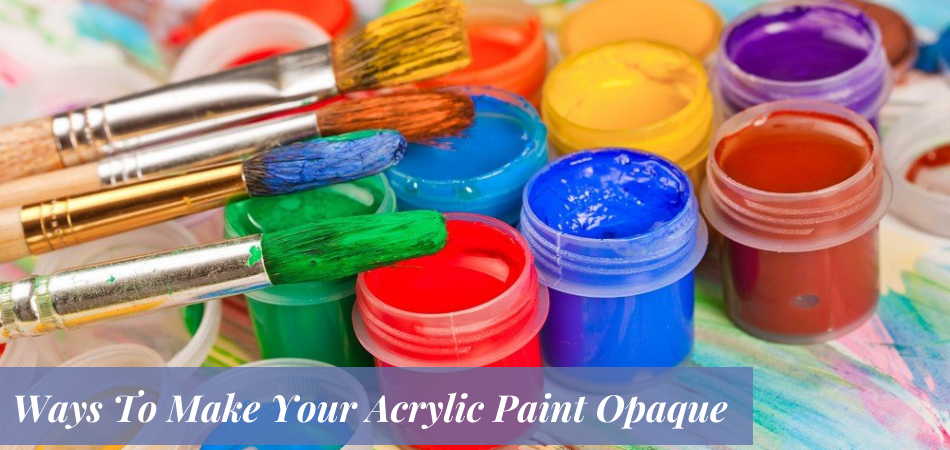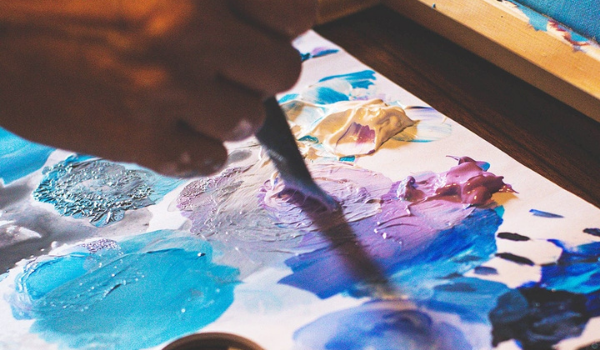Randy Charles is the owner of PaintCentric.com, a website dedicated to providing information, tips, tricks, and news about all things paint. With over 10 years...Read more
Acrylic paint is a great choice for art and craft projects. But, sometimes you want an opaque color. Here are five ways to make your acrylic paint opaque:
- Add white acrylic paint.
- Try using a glazing medium.
- Paste extenders can help.
- Thin the paint with a water-soluble medium.
- Add an absorbent ground.
These methods can help you get the results you want. Let’s get started!

Adding White Paint
White paint’s white tint can make acrylic paint more opaque. It reduces transparency, which helps to get an even finish. Thus, many artists employ this method to get the desired results.

Use White Paint to Make Colors More Opaque
Want to make your acrylic paint colors more opaque? White paint is a good solution. It will deepen and enrich the color without changing its hue. Also, it can make the transparent colors more opaque so the surface beneath won’t show through. To use it, just mix a bit of white with your colors and adjust until you get the desired effect.
Plus, you can apply two to three coats of white acrylic over the transparent colors. This will offer protection against painting mediums like gels. Just be careful not to use too much white – this can darken the color. So, test it before deciding on the combination!
Use White Paint to Create a Chalk-Like Effect
White paint is a great way to make your acrylic paints look like chalk. It has the opacity to cover any underlying colors while still making art look vibrant.
To get started, pick a titanium-based white paint – it’s the best for covering. Brushstrokes and feathering can be used for larger areas. For small details, try using small brushes and drippings of white. Go wild – you can layer multiple whites to make your artwork pop!
Adding Gesso
Want to make your acrylic paint opaque and thicker? Add Gesso! It’s a white primer that preps a painting surface for acrylic paint. Mixing it in will give your paint a professional look with opaqueness and more layers.
Let’s explore the best methods for adding Gesso to your paint:
Use Gesso to Make Colors More Opaque
Gesso is a white, liquid primer made of chalk, talc and linseed oil. It can be applied directly onto canvas or boards to give a smoother and brighter finish. The opacity depends on the number of coats you add – the more you add, the more coverage you get.
Artists who like thick brushstrokes should use gesso-like products. It creates an even opaque surface, allowing for color blocking and painting with intense shades. Plus, you can still mix in mediums like acrylic glazing liquid or water-thinned glazes to create translucent pieces.
Professional grade gessos usually include better ingredients than student grade products. For long-term permanence, many artists prefer materials designed specifically for acrylic paints. These primers help repair any textural issues, while also preserving artworks from environmental damage longer.
Use Gesso to Create a Chalk-Like Effect
Gesso is an awesome way to give your acrylic paint an opaque, chalky texture. It’s made with pigment, chalk and binder – you can even make it at home with water, plaster of Paris and white glue. The viscosity is important – it needs to be thick enough so it acts as a buffer between the existing paint and your artwork surface.
If you’re adding gesso over existing acrylic paint, work in thin layers and let each layer dry before moving on. Depending on how visible your original art is, you may need to use two or more coats. Then you can start layering colors for a 3D effect.
Gesso can be used on:
- Small canvases
- Jewelry boxes
- Wall art pieces
- Murals or outdoor installations
Vary your consistencies and painting techniques for creative possibilities and make your artwork truly unique!
Adding Mediums
Acrylic painting can be made more opaque and smooth with the addition of mediums. Mediums range from matte to gels. They can also help improve adhesion, brushability, and handling.
Here are some mediums that make acrylic paint more opaque:
- Matte mediums
- Gels
- Adhesive enhancers
- Brushability improvers
- Handling aids
Use Mediums to Make Colors More Opaque
Mediums are items for mixing with acrylic paint. They can turn a transparent color into something opaque. Popular and effective mediums for making paint more opaque include: Gesso, Matte Medium, and Glazing Medium.
- Gesso is a white paste used as an acrylic medium. It seals and enhances the underlying surface, improving adhesion.
- Matte Medium increases opacity and gives a low-gloss finish.
- Glazing Medium improves gloss retention in extreme weather. It must be applied over dried paint layers, at least 24 hours prior.
Use Mediums to Create a Chalk-Like Effect
You can create a chalk-like effect with acrylic paints. This is great for a powdery finish and adding texture. Gesso, Titanium White, and Texture Medium are the most common mediums for this.
- Gesso prepares the painting’s surface for art materials.
- Titanium White mixed with water gives paint a chalky appearance.
- Texture medium, paste-like, added to wet paint with a brush or palette knife gives extra texture.
- Mixing Titanium White and Texture Medium gives mounds that look like ribbons or folds in the finished artwork, adding beauty, shape, dimension and even movement!
Conclusion
Making acrylic paints opaque is awesome for creating fabulous paintings. You can do it in a few ways:
- Traditional techniques like using heavy body acrylics, adding more color, and increasing the paint’s thickness are great for lasting opacity.
- For something unique, experiment with light-reflective elements and prisms.
- Or use gels and mediums for final touches.
- For a transparent effect, dilute acrylics with water or other liquid mediums.
These tips can help you get the opacity you want!
Frequently Asked Questions
What are some ways to make acrylic paint more opaque?
One way to make acrylic paint more opaque is to add a white acrylic paint to the color. You can also use a medium, such as retarder or an additive like matte medium, to make the paint more opaque. Finally, you can also add an extra layer of paint to help make the paint more opaque.
How do you use a medium to make acrylic paint opaque?
To use a medium to make acrylic paint more opaque you will need to mix the medium with the paint. The ratio of medium to paint will vary depending on what medium you are using, so be sure to check the directions on the medium. Once the medium and paint are mixed, you can apply the mixture to your painting surface.
How do you use an additive to make acrylic paint opaque?
To use an additive such as matte medium to make acrylic paint more opaque, you will need to mix the additive with the paint. The ratio of additive to paint will vary depending on what additive you are using, so be sure to check the directions on the additive. Once the additive and paint are mixed, you can apply the mixture to your painting surface.
Related:

Randy Charles is the owner of PaintCentric.com, a website dedicated to providing information, tips, tricks, and news about all things paint. With over 10 years of experience in the painting industry, Randy has become an expert in the field and is passionate about helping others learn more about painting. He has written numerous articles on the subject and is committed to providing accurate and up-to-date information to his readers.
- Latest Posts by Randy Charles
-
How to get paint off a mirror?
- -
How much does it Cost to Paint a Car? – All You Know is Here
- -
How much does Car Paint Cost? – Get To Know Here
- All Posts
